Polish actor and singer Jan Kiepura (1902-1966) was one of the grand tenors of the 20th century. With his handsome smile, he also became a popular star of the early German sound film. Solo, and together with Marta Eggerth, he starred in many popular film operettas of the 1930s, often produced in multiple-language versions.
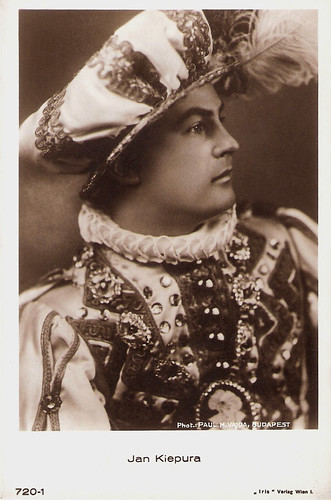
Austrian postcard by Iris-Verlag, Wien, no. 720-1. Photo: Paul M. Vajda, Budapest.
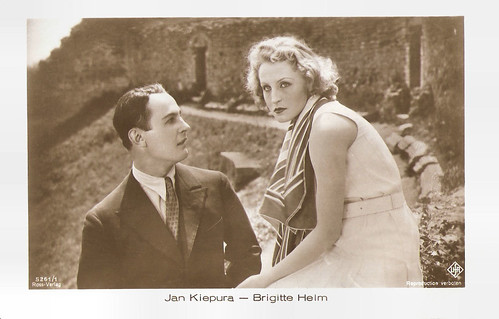
German postcard by Ross Verlag, no. 5261/1, 1930-1931. Photo: Ufa. Publicity still for Die singende Stadt/The Singing City (Carmine Gallone, 1930).
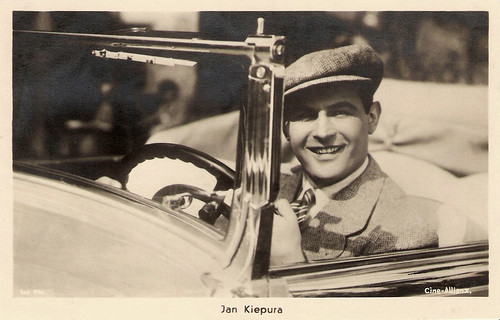
Postcard by Iris-Verlag. Photo: Lux Film / Cine-Allianz. Publicity still for Das Lied einer Nacht (Anatole Litvak, 1932).
Jan Wiktor Kiepura was born as the son of a Polish baker and a Jewish mother in the mining town of Sosnowia, Russia (now Poland). He started studying law in Warsaw, but at the same time, he took singing lessons with Waclaw Brzesinsky and Tadeusz Leliwa.
He soon realized that singing was his real vocation and he gave his first concert in 1924. In 1925 he made his big debut as the lead singer of Charles Gounod's 'Faust'.
In the following months, he gained popularity singing in 'Rigoletto' by Giuseppe Verdi, 'Halka' by Stanisław Moniuszko, and 'Cavalleria Rusticana' by Pietro Mascagni, at the Warsawian Wielki Theater.
He made an appearance on the Polish radio and the cinema also required him. He made his film debut in the silent Polish production O czym się nie myśli/Not In Your Thoughts (Edward Puchalski, 1926).
From then on, Kiepura was wanted everywhere in the world and he would perform even at La Scala in Milan and the Metropolitan in New York.

German collectors card in the series 'Vom Werden deutscher Filmkunst - Der Tonfilm', album no. 11, picture no. 31. Photo: Ufa / Ross Verlag. Jan Kiepura and Brigitte Helm in Die singende Stadt/The Singing City (Carmine Gallone, 1930).
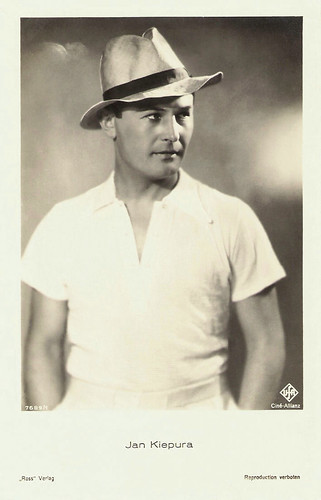
German postcard by Ross Verlag, Berlin, no. 7689/1, 1932-1933. Photo: Ciné Allianz / Ufa.
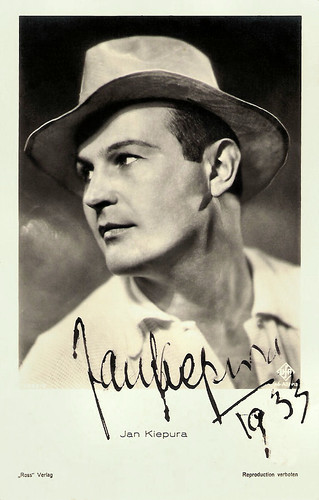
German postcard by Ross Verlag, Berlin, no. 7689/2, 1932-1933.
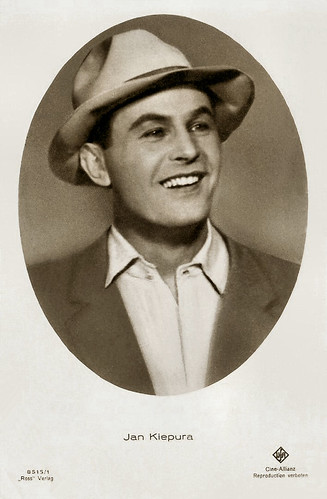
German Postcard by Ross Verlag, no. 8515/1, 1933-1934. Photo: Ufa / Cine-Alianz.
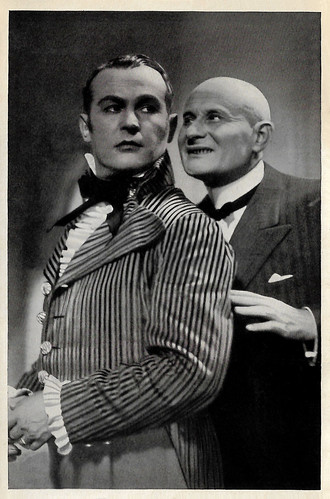
German collectors card in the series 'Vom Werden deutscher Filmkunst - Der Tonfilm', album no. 11, picture no. 32. Photo: Cine-Allianz / Ross Verlag. Jan Kiepura and Julius Falkenstein in Das Lied einer Nacht/The Song of Night (Anatole Litvak, 1932).
When the sound film arrived, Jan Kiepura was already a world-famous opera star and with his beautiful tenor and his good looks he proved to be perfect for the German film operetta.
His first sound film was Die singende Stadt/City of Song (Carmine Gallone, 1930), shot at the Ufa studios at Neu Babelsberg. He played a naïve, good-natured singing sensation lured to fame and fortune by a big city vamp. She was played in the German version by Brigitte Helm and in the English language release by Betty Stockfeld.
Kiepura himself lured a huge public into the cinemas with Das Lied einer Nacht/Tell Me Tonight (Anatole Litvak, 1932) and Ein Lied für Dich/A Song for You (Joe May, 1933).
On the set of Mein Herz ruft nach dir/My Heart Calls You (Carmine Gallone, 1934), he met the Hungarian lyrical soprano Marta Eggerth, who would become the woman of his life. The two often sang together in operettas, in concerts, on records, and in films. The greatest success of this dazzling dream couple was Zauber der Bohème/Magic of the Bohemians (Géza von Bolváry, 1937).
Kiepura showed his acting skills in a double role in Ich liebe alle Frauen/I Love All Women (Carl Lamac, 1935) with Theo Lingen and Lien Deyers, and its French version J'aime toutes les femmes (Carl Lamac, 1935) with Danielle Darrieux and English version Give Us This Night (Alexander Hall, 1936).
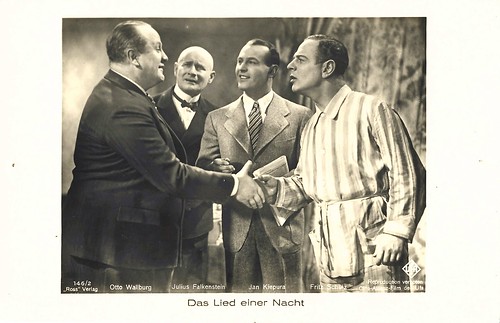
German postcard by Ross Verlag, no. 146/2. Photo: Cine-Allianz-Film der Ufa. Otto Wallburg, Julius Falkenstein, Jan Kiepura and Fritz Schulz in Das Lied einer Nacht/The Song of Night (Anatole Litvak, 1932).

German postcard by Ross Verlag, no. 146/4. Photo: Cine-Allianz Film der Ufa. Jan Kiepura and Magda Schneider in Das Lied einer Nacht/The Song of Night (Anatole Litvak, 1932).

German postcard by Ross Verlag, no. 8612/1, 1933-1934. Photo: Ufa/Cine-Allianz. Still from Mein Herz Ruft nach Dir (Carmine Gallone, 1934).

German postcard by Ross Verlag, no. 198/1. Photo: Cine Allianz / Ufa. Jan Kiepura and Martha Eggerth in the musical comedy Mein Herz ruft nach dir (Carmine Gallone, 1934).

German postcard by Ross Verlag, no. 8583/1, 1933-1934. Photo: Ufa / Cine-Allianz / Frhr. von Gudenberg.
In March 1938 Jan Kiepura and Marta Eggerth (who was also partially Jewish) were forced to flee Europe due to the rise of Nazism. They took refuge in the South of France.
After World War II broke out, Kiepura was located in Paris. When France capitulated he went with Eggerth to New York. There he supported organisations like the Relief Fund for Poland. Kiepura en Eggerth caused a sensation on Broadway where they co-starred in 'The Merry Widow' and 'La Polonaise'.
After the war, they returned to Paris and starred in films like Addio Mimi!/Her Wonderful Lie (Carmine Gallone, 1947) - a modern adaptation of Giacomo Puccini's opera 'La Boheme', Valse brillante/Brilliant Waltz (Jean Boyer, 1949) and Das Land des Lächelns/Land of Smiles (Hans Deppe, Erik Ode, 1952).
In 1953, they settled down in the USA for good. Kiepura acquired American citizenship shortly afterwards. However, his career quickly declined.
At the age of 64, Jan Kiepura died of a heart attack in Harrison, in his New York State home, in 1966. He and Marta Eggerth had two sons.

Dutch postcard by Croese & Bosman, no. 524. Photo: Universal Film.

Latvian postcard by Ira, Riga, no. 1839. Photo: Jan Kiepura and Lien Deyers in Ich liebe alle Frauen (Carl Lamac, 1935).

German postcard by Das Programm von Heute. Photo: Intergloria / Terra Filmkunst.

German postcard by Ross Verlag, no. A 1199/1. Photo: Paramount. Martha Eggerth and Jan Kiepura in front of their hotel Patria in Krynica-Zdrój, a popular Polish ski resort, near the Czech border.
This luxurious modernist Hotel Patria, commissioned by Jan Kiepura, was designed by architect Bohdan Pniewski in 1927 and opened in 1933. It had cost Kiepura 3 million dollars, gathered by his successful musicals in Europe and the US.
Soon it became the toast of the town, attracting nobility and nouveaux-riches. It was run by Kiepura's parents, while Kiepura and Eggerth lived in Paris.
In January 1937 it was the site of a royal scandal when the just-married Dutch crown princess Juliana and her husband Bernhard, Prince zur Lippe-Biesterfeld, had tried to deceive the press, by sending their luggage elsewhere and hiding at the Hotel Patria. Soon their incognito count and countess Von Sternberg [!] came out and the press sieged the hotel, while Kiepura and Eggerth came back overnight from Paris to welcome the royal guests.
The weeks in Patria must have been big fun for the royal couple, filled with skiing in the daytime and parties in the nighttime. Marta Eggerth later remembered how she had fun with the couple, changing the ski boots in front of the hotel rooms in the middle of the night.
During the war, the hotel was used as a sanatorium for German officers. After the war, the hotel was expropriated by the communists and became a state health resort. When Jan Kiepura visited Krynica in 1958 he was not allowed to stay there. After his death, Marta Eggerth tried in vain to reclaim the building.

German postcard by Ross Verlag, no. 9327/1, 1935-1936. Photo: Neuhauser, St. Moritz.

German postcard by Ross Verlag, no. 9877/1, 1935-1936. Photo: Paramount.
Jan Kiepura sings 'La Boheme'. Source: Tenor65 (YouTube).
Jan Kiepura sings 'La donna e mobile'. Source: Tenor65 (YouTube).
Sources: Hans-Michael Bock (The Concise Cinegraph), Thomas Staedeli (Cyranos), Guy Bellinger (IMDb), Wikipedia, and IMDb.
This post was last updated on 25 December 2024.

Austrian postcard by Iris-Verlag, Wien, no. 720-1. Photo: Paul M. Vajda, Budapest.

German postcard by Ross Verlag, no. 5261/1, 1930-1931. Photo: Ufa. Publicity still for Die singende Stadt/The Singing City (Carmine Gallone, 1930).

Postcard by Iris-Verlag. Photo: Lux Film / Cine-Allianz. Publicity still for Das Lied einer Nacht (Anatole Litvak, 1932).
The simple boy from Sosnowia
Jan Wiktor Kiepura was born as the son of a Polish baker and a Jewish mother in the mining town of Sosnowia, Russia (now Poland). He started studying law in Warsaw, but at the same time, he took singing lessons with Waclaw Brzesinsky and Tadeusz Leliwa.
He soon realized that singing was his real vocation and he gave his first concert in 1924. In 1925 he made his big debut as the lead singer of Charles Gounod's 'Faust'.
In the following months, he gained popularity singing in 'Rigoletto' by Giuseppe Verdi, 'Halka' by Stanisław Moniuszko, and 'Cavalleria Rusticana' by Pietro Mascagni, at the Warsawian Wielki Theater.
He made an appearance on the Polish radio and the cinema also required him. He made his film debut in the silent Polish production O czym się nie myśli/Not In Your Thoughts (Edward Puchalski, 1926).
From then on, Kiepura was wanted everywhere in the world and he would perform even at La Scala in Milan and the Metropolitan in New York.

German collectors card in the series 'Vom Werden deutscher Filmkunst - Der Tonfilm', album no. 11, picture no. 31. Photo: Ufa / Ross Verlag. Jan Kiepura and Brigitte Helm in Die singende Stadt/The Singing City (Carmine Gallone, 1930).

German postcard by Ross Verlag, Berlin, no. 7689/1, 1932-1933. Photo: Ciné Allianz / Ufa.

German postcard by Ross Verlag, Berlin, no. 7689/2, 1932-1933.

German Postcard by Ross Verlag, no. 8515/1, 1933-1934. Photo: Ufa / Cine-Alianz.

German collectors card in the series 'Vom Werden deutscher Filmkunst - Der Tonfilm', album no. 11, picture no. 32. Photo: Cine-Allianz / Ross Verlag. Jan Kiepura and Julius Falkenstein in Das Lied einer Nacht/The Song of Night (Anatole Litvak, 1932).
Dazzling dream couple
When the sound film arrived, Jan Kiepura was already a world-famous opera star and with his beautiful tenor and his good looks he proved to be perfect for the German film operetta.
His first sound film was Die singende Stadt/City of Song (Carmine Gallone, 1930), shot at the Ufa studios at Neu Babelsberg. He played a naïve, good-natured singing sensation lured to fame and fortune by a big city vamp. She was played in the German version by Brigitte Helm and in the English language release by Betty Stockfeld.
Kiepura himself lured a huge public into the cinemas with Das Lied einer Nacht/Tell Me Tonight (Anatole Litvak, 1932) and Ein Lied für Dich/A Song for You (Joe May, 1933).
On the set of Mein Herz ruft nach dir/My Heart Calls You (Carmine Gallone, 1934), he met the Hungarian lyrical soprano Marta Eggerth, who would become the woman of his life. The two often sang together in operettas, in concerts, on records, and in films. The greatest success of this dazzling dream couple was Zauber der Bohème/Magic of the Bohemians (Géza von Bolváry, 1937).
Kiepura showed his acting skills in a double role in Ich liebe alle Frauen/I Love All Women (Carl Lamac, 1935) with Theo Lingen and Lien Deyers, and its French version J'aime toutes les femmes (Carl Lamac, 1935) with Danielle Darrieux and English version Give Us This Night (Alexander Hall, 1936).

German postcard by Ross Verlag, no. 146/2. Photo: Cine-Allianz-Film der Ufa. Otto Wallburg, Julius Falkenstein, Jan Kiepura and Fritz Schulz in Das Lied einer Nacht/The Song of Night (Anatole Litvak, 1932).

German postcard by Ross Verlag, no. 146/4. Photo: Cine-Allianz Film der Ufa. Jan Kiepura and Magda Schneider in Das Lied einer Nacht/The Song of Night (Anatole Litvak, 1932).

German postcard by Ross Verlag, no. 8612/1, 1933-1934. Photo: Ufa/Cine-Allianz. Still from Mein Herz Ruft nach Dir (Carmine Gallone, 1934).

German postcard by Ross Verlag, no. 198/1. Photo: Cine Allianz / Ufa. Jan Kiepura and Martha Eggerth in the musical comedy Mein Herz ruft nach dir (Carmine Gallone, 1934).

German postcard by Ross Verlag, no. 8583/1, 1933-1934. Photo: Ufa / Cine-Allianz / Frhr. von Gudenberg.
Sensation on Broadway
In March 1938 Jan Kiepura and Marta Eggerth (who was also partially Jewish) were forced to flee Europe due to the rise of Nazism. They took refuge in the South of France.
After World War II broke out, Kiepura was located in Paris. When France capitulated he went with Eggerth to New York. There he supported organisations like the Relief Fund for Poland. Kiepura en Eggerth caused a sensation on Broadway where they co-starred in 'The Merry Widow' and 'La Polonaise'.
After the war, they returned to Paris and starred in films like Addio Mimi!/Her Wonderful Lie (Carmine Gallone, 1947) - a modern adaptation of Giacomo Puccini's opera 'La Boheme', Valse brillante/Brilliant Waltz (Jean Boyer, 1949) and Das Land des Lächelns/Land of Smiles (Hans Deppe, Erik Ode, 1952).
In 1953, they settled down in the USA for good. Kiepura acquired American citizenship shortly afterwards. However, his career quickly declined.
At the age of 64, Jan Kiepura died of a heart attack in Harrison, in his New York State home, in 1966. He and Marta Eggerth had two sons.

Dutch postcard by Croese & Bosman, no. 524. Photo: Universal Film.

Latvian postcard by Ira, Riga, no. 1839. Photo: Jan Kiepura and Lien Deyers in Ich liebe alle Frauen (Carl Lamac, 1935).

German postcard by Das Programm von Heute. Photo: Intergloria / Terra Filmkunst.

German postcard by Ross Verlag, no. A 1199/1. Photo: Paramount. Martha Eggerth and Jan Kiepura in front of their hotel Patria in Krynica-Zdrój, a popular Polish ski resort, near the Czech border.
A royal scandal
This luxurious modernist Hotel Patria, commissioned by Jan Kiepura, was designed by architect Bohdan Pniewski in 1927 and opened in 1933. It had cost Kiepura 3 million dollars, gathered by his successful musicals in Europe and the US.
Soon it became the toast of the town, attracting nobility and nouveaux-riches. It was run by Kiepura's parents, while Kiepura and Eggerth lived in Paris.
In January 1937 it was the site of a royal scandal when the just-married Dutch crown princess Juliana and her husband Bernhard, Prince zur Lippe-Biesterfeld, had tried to deceive the press, by sending their luggage elsewhere and hiding at the Hotel Patria. Soon their incognito count and countess Von Sternberg [!] came out and the press sieged the hotel, while Kiepura and Eggerth came back overnight from Paris to welcome the royal guests.
The weeks in Patria must have been big fun for the royal couple, filled with skiing in the daytime and parties in the nighttime. Marta Eggerth later remembered how she had fun with the couple, changing the ski boots in front of the hotel rooms in the middle of the night.
During the war, the hotel was used as a sanatorium for German officers. After the war, the hotel was expropriated by the communists and became a state health resort. When Jan Kiepura visited Krynica in 1958 he was not allowed to stay there. After his death, Marta Eggerth tried in vain to reclaim the building.

German postcard by Ross Verlag, no. 9327/1, 1935-1936. Photo: Neuhauser, St. Moritz.

German postcard by Ross Verlag, no. 9877/1, 1935-1936. Photo: Paramount.
Jan Kiepura sings 'La Boheme'. Source: Tenor65 (YouTube).
Jan Kiepura sings 'La donna e mobile'. Source: Tenor65 (YouTube).
Sources: Hans-Michael Bock (The Concise Cinegraph), Thomas Staedeli (Cyranos), Guy Bellinger (IMDb), Wikipedia, and IMDb.
This post was last updated on 25 December 2024.
1 comment:
Wow, you have an amazing collection here! Thanks for coming by my blog, The Cedar Chest
Post a Comment